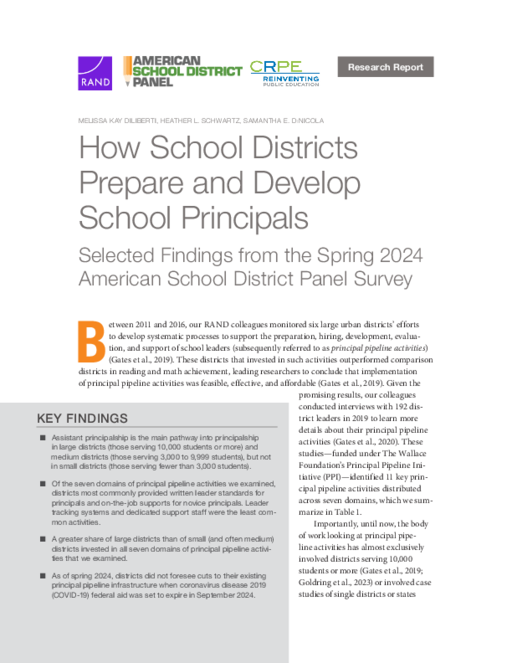- Author(s)
- Melissa Kay Diliberti, Heather L. Schwartz, and Samantha E. DiNicola
- Publisher(s)
- RAND Corporation
Research Approach
Survey:
All districts enrolled in the American School District Panel (ASDP) were invited to complete the spring 2024 ASDP survey from March 6 through May 3, 2024. Of the 1,318 public school districts that enrolled in the panel between fall 2020 and spring 2024, 190 districts completed enough of the survey to receive a weight. The ten-minute survey was designed to allow multiple different respondents from the same district central office to complete portions of the survey. The researchers recommended that an HR director or principal supervisor complete the survey items that were analyzed in this report. However, the researchers do not know which person(s) in each district completed the survey on behalf of their district.
Survey responses were weighted to be representative of the national population of public school districts across several dimensions, including district enrollment size, geographic region, locale, and free or reduced-price meal eligibility. For more information about the sampling and weighting procedures for the spring 2024 ASDP survey, see Grant et al. (2024).
Data were not designed to be representative of the national population of public school students. Students are not evenly distributed across school districts.
Analysis:
The researchers examined differences in districts’ responses to the spring 2024 survey by district enrollment size. They obtained data on district enrollment size by linking
survey data files to the 2021–2022 Common Core of Data issued by the National Center for Education Statistics. They categorize districts that enroll fewer than 3,000 students as small and districts with more than 10,000 as large; they categorize the remaining districts as medium.
The researchers conducted significance testing to assess whether subgroups were statistically different at the p < 0.05 level. In this report, they call attention to only differences that are statistically significant at the 5-percent level, unless otherwise noted. Because of the exploratory nature of this study, they did not apply multiple hypothesis test corrections. Researchers can download survey data files to perform their own analyses by visiting the American Educator Panels Data Portal available on www.rand.org/aep.

